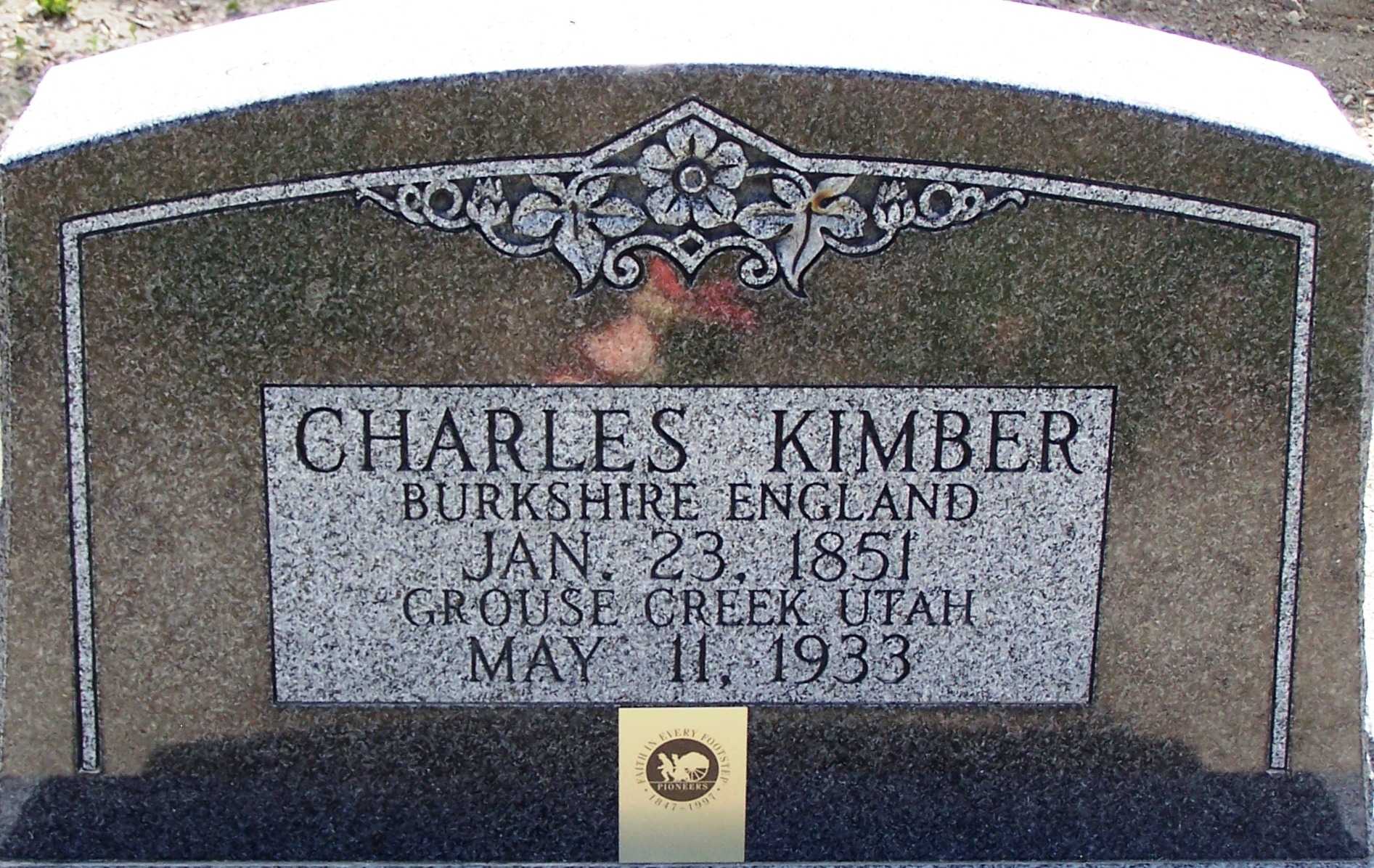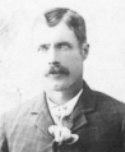 Charles Kimber was born in Bucklebury, Berkshire, England, on January 23, 1851. Born of Mormon parents, his father was Charles Kimber Sr., born onAugust 31, 1818. His mother was Caroline Sellwood, born on March 23, 1816. For six weeks Charles attended the Blue School, located at Courage, England, some three miles from their home. He attended night school for two winters. Charles also attended cottage meetings of the Latter-day-Saints church and was baptized in 1859.
Charles Kimber was born in Bucklebury, Berkshire, England, on January 23, 1851. Born of Mormon parents, his father was Charles Kimber Sr., born onAugust 31, 1818. His mother was Caroline Sellwood, born on March 23, 1816. For six weeks Charles attended the Blue School, located at Courage, England, some three miles from their home. He attended night school for two winters. Charles also attended cottage meetings of the Latter-day-Saints church and was baptized in 1859.
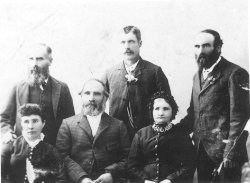
Edward, Charles Jr, William, Elizabeth, Charles Sr & Caroline Kimber
At the age of seventeen, his parents, with their family, decided to come to America. They brought Charles, his brother William James, his sister Elizabeth Ann and a granddaughter, Ellen Hannah. They sailed on Saturday, June 20, 1868, from Liverpool on the packet ship Emerald Isle. There were 876 saints aboard, under the direction of Hans Jensen Hals, arriving in New York Harbor on August 11, 1868. This was a very unpleasant voyage as the machine, which purified the water for drinking broke and they had to return to Ireland for several days. The ocean was rough and Charles was very sick most of the way. Thirty-seven deaths occurred on the ocean and others died in the hospital in New York. They were six weeks on the ocean arriving at New York on August 11 and landing on August 14, 1868.
The family traveled by train from New York to Council Bluffs, then traveled in Union Pacific cattle cars to Fort Benton on the North Platt River about 700 miles west of Omaha, arriving on August 25. Here Ellen Hannah died at the age of four years. She was buried and they rested for a few days then continued their journey onto Salt Lake Cityby mule train. While on the plains, Charles had mountain fever and was very sick. As near as can be told by church chronology, they arrived in Salt Lake City by Edward T. Mumford’s mule train on Thursday, September 24, 1868. There were twenty-eight wagons and 250 passengers in this train.
The family, Charles Sr. and his children, then went from Salt Lake City to Tooele where they made their home. Caroline Sellwood Kimber’s brother, William Sellwood, lived in Tooele, but it is not known if he arrived there before or after the Kimber family came.

Edward, Charles Jr., William & Elizabeth Kimber
After Charles Jr. arrived in Tooele, he had several attacks of appendicitis. Charles was not a large man. He was about 5’7″ tall and weighed about 165-170 pounds. He was a well-built man physically. He was stately and stood tall. Charles wore a mustache so his lips did not get sore. He had a little red in his mustache and black hair. Charles was also plagued with cataracts in his eyes in later years making his eyes run a lot.
On November 16, 1874, Charles Kimber Jr. and Sarah Elizabeth Morgan were married in the Endowment House in Salt Lake City by D.H. Wells. They had nine children. Charles Kimber Sr. and Caroline Sellwood Kimber went to the temple the same day and had their endowments. They were sealed by Wilford Woodruff. Mr. and Mrs. Albert Richins were also married the same day.
The following children were born to Charles Kimber Jr. and Sarah Elizabeth Morgan: Elizabeth Ann, Charles William, George, Elmer, Ellen, Evan Osborne, Frank, Louisa and Sarah Elizabeth, who died as an infant.
Just about the time Charles Jr. was married, he was working in a sawmill and had the misfortune to get two of his fingers cut off. This accident came near taking his life through loss of blood. It was also a great expense as he had to go to the doctor in Salt Lake City for medical care.
In 1875 it was learned that there was good virgin soil in the northwest corner of the state so he and his brother, William, came to Grouse Creek to investigate. Charles moved his family to Grouse Creek and made a home where the Kimber ranch is on the flat. Charles made his living for some time raising, buying and selling horses, also catching and breaking wild horses. He had several hundred head at one time and used to have the outfit and ride for horses the same as for cattle. Charles ran them on Dean’s pass and some on Gopher Mountain and Copper Mountain. He bought some from Mrs. Terrell, Benny Cook, Warburtons and Valison Tanner. He hired Wilford Richins and Thomas E. Kimber to herd them. One year they gathered 1,000 head of horses. They loaded them on the train in four or five box cars at Kelton and George, took them to Chicago and sold them for $6.00 a head.
One day, while Charles lived on the ranch, he was on the range and his horse fell with him, causing his family to despair for his life, but he rallied and became well. Some time after this, while working with wild horses, he got the end of his left fore finger pulled off.
About this time Charles traded his share in the Kimber Ranch for what is now William Ballingham’s home at the head of Grouse Creek, where he lived for about eleven years.
Charles traded his home where Oren now lives to D.P. Thomas and moved back to Huntington, along with Philip Paskett, taking a herd of horses. They spent the winter of 1891 there. (See the excerpt of Huntington trip.)

Charles Jr & Josie Kimber
In 1892 Charles built the Aunt Lizzie house for his sister. On October 26, 1892 Sarah E. died in childbirth. Aunt Lizzie took in the family and kept the baby, Sarah, which died at two months. Charles, Billie Kimber, George Kimber and Tom Warburton went back to Huntington taking more horses which he bought from McCustion, Ross Warburton and Ben H. Cook. They lived all winter in a tent. The next spring in 1893 Charles returned. He had shaved his whiskers off and the children didn’t know him.
That winter he courted Persis Josephine Laird in Goshen. They were married on June 14, 1893 in Logan. Charles then built a two-room log house north of where Richins’s “green house” stands. This union produced twelve children: Chloe, Mary, Winfred, Florence, Raymond, Edwin, Vera, James, Oren, Fern, Elsie and Charles.
Charles had a way of handling his children. They all got along well. He never had any trouble with anyone that Winfred, his son, can recall, nothing of any consequence any time. Winfred cannot remember of him having troubles much. “With us boys, why dad was the boss and that’s the way we worked.” The worst punishment the kids got was a snap. Charles must have worried, but never showed it. He had a way of carrying out his responsibilities.
His daughter’s, Vera Kimber Tanner, impression of her dad was that he never lost control of his temper. He had control of his children without dire punishment. His children always had respect for him. She can’t remember her dad or mother quarreling.
Charles did lots of work in his blacksmith shop. He shod lots of horses. He would spend a week or so with his sons, shoeing horses before outfit time. The blacksmith shop was his hobby and he loved to tinker in it.
Charles Kimber and Philip Paskett went and cared for the sick when the diphtheria epidemic was at Grouse Creek. While they were at Warburtons, where they stayed for several days, they had an experience with evil spirits. The room had no ceiling and the spirits could be seen in the rafters. They were undoubtedly trying to take possession of the sick members of the family but were prevented from doing so when rebuked by the Priesthood.
Charles made his own adobe and built an adobe house. It was the south building of the two original houses on the ranch. The house had a fireplace with a shelf. They cooked pine nuts there after going pine nut hunting.
A sister was left in England when the rest of the family came to America. Winfred remembers she had some property which, upon her death, the family could have received if someone had gone over to England. For some reason Charles could not go back and none of the rest of the family did either.
Brother Charles Kimber Jr. and family, Brother Paskett and family and Heber Shaw started from Grouse Creek to go south to seek a new location in 1891. When they had traveled about one and one-half miles, the tire ran off of one of the wagons belonging to brother Paskett, breaking every spoke in the wheel. Alma Tanner, who was going with them to Tooele, put the wheel together and with the tire they reached Bishop Charles Kimber Sr. place that night, where all were kindly entertained, teams fed and the loose horses, numbering about ninety head, were put in Bishop Kimber’s field. There was a dance that same evening at Mr. George Cook’s.
The next morning they started out on their journey and everything went along fine until they reached the Southern Pacific railroad. There they crossed the tracks but in doing so the tongue was broken out of one of the wagons and the sway bar of another. After fixing the wagons the group traveled toward Bull Springs three miles south of the railroad track. After traveling a short distance they realized they were not on the right road, the wagons cut down in the desert mud making it hard pulling. Heber Shaw, driving two span of good horses and a heavily loaded wagon got stuck in the mud. Two wheels settled rather deep when the horses stopped. When the team began to pull again, the fifth chain broke and the lead horses broke away taking the stretches with them. The horses began to run full speed and after circling several times, one horse, worth $100.00 and belonging to Charles Kimber, stumbled over a bump and turning a complete somersault broke his neck. This incident caused a feeling of gloom in the company.
Camp was made at Bull Springs and at night they herded the horses. Next morning the men returned for Heber Shaw’s wagon. After dinner, about 2:00 the company started to cross the desert. Alma Tanner took the lead with Heber Shaw’s wagon directly after. Charles Kimber, driving two span got stuck in the mud before leaving the spring and had to unload part of his wagon to get out. All went well for about five miles until attempting to cross a slough. Heber Shaw’s wagon again became stuck. Charles Kimber took the lead horse off his wagon to help pull Shaw out. Then upon trying to cross himself, Kimber’s wagon got stuck and had to be pulled out backwards. The second attempt to cross was successful. The party reached Newfoundland late the same night, where they stayed for six days. Some of the horses broke away and returned to Grouse Creek, Charles Kimber and Heber Shaw went after them finding them at Red Butte, in lower Grouse Creek.
The party started from Newfoundland on a Wednesday afternoon and crossed the second desert that night. The next night they reached Grass Mountain and on November 6, reached Cook Springs, then traveled on to Tinpy Springs on November 7, where they stayed for two days. Some of the horses had gone back along the trail but were found. The men reached Parley Kimball’s ranch near Grantsville on November 9th and November 10th they reached Tooele and stayed three days. On November 14, camp was made at St. John for over Sunday, then to Camp Floyd on the 16th. On November 17 they reached Jasper’s Ranch near Goshen, where they lost four horses belonging to Philip Paskett. On the 19th of November they reached Mona. November 20 found them camping at Fountain Green for lunch, the 21st at Fairview, and the 22nd for Sunday. On the following Monday, a gradual ascent was begun over the Rocky Mountains by way of Cottonwood canyon. The group traveled twelve miles of steep and icy ground. They were forced to leave one wagon while the rest traveled to Flat Canyon, twenty miles from Cottonwood Canyon and 9875 feet above sea level. On November 24, Charles Kimber and Philip Paskett went back for the abandoned wagon. After a hectic experience of trying to get the wagons up the steep and slippery banks of the creek bed, travel was resumed.
Camp that night was made at Opal Beds, five miles from Flat Canyon. There was no feed for the horses so they had to be herded all night. On November 25 the trail led down Huntington Canyon, the party covered ten miles crossing the river some fifteen times. The following day, crossing the river an additional eight times, and traveling some miles, they reached Big Matts Ranch, five and one half miles from Huntington. The group had traveled forty-five miles in four days through timber – pine, quaking asp, and cottonwood – and arrived at Huntington on November 26, 1891.
While living in Huntington, Byron Barthoff had bought deer that the Indians killed in Uinta county and hired Charles Kimber and Elmer Kimber, Ed Geaty, Joe Wybe, Dave Olmstead and Andrew Allen to haul them to Colorado to sell. At Price the men loaded all hindquarters in the wagons. At Grand Junction the government confiscated the deer they said were illegal. Byron Barthoff was arrested and put into jail. The rest were released and received their pay, also enough meat for their trip home. They started for home again taking a wagon load of asphaltum or gilsonite from Ft. Duchesne. On the way Andrew Allen’s wagon hit a rock and threw him off, crushing him. Olmstead was sent to take the corpse to Huntington. Elmer Kimber said he was really frightened to be hauling a dead man.
In June 1892, Charles Kimber Jr. started to Grouse Creek, camping the first night at Price. On June 4 they had lunch at Coal Springs, traveled nine miles and camped that night at the mouth of Whittmore Wash. Next day they traveled twenty-seven miles and camped at the Rock Quarry near the head of Price Canyon. On June 6 they traveled ten miles to the Denver and Rio Grande railroad, the same afternoon traveled fifteen miles and camped at the head of Spanish Fork Canyon. On June 7 they traveled eight miles, and on June 8 they progressed twenty miles and reached Mapleton, where hay cost fifty cents for the horses. On June 9 they nooned near Provo River and camped at Lehi for the night. On June 10 they nooned at Sandy then went to Salt Lake City where they stayed three days with Aunt Magg (Sarah Elizabeth’s sister.) On June 13 they traveled twenty miles to Layton and camped for the night. They spent one night in Ogden, one in Willard and one on the Bear River at Corrine. From Corrine to Conner Spring near Promontory. After traveling fifteen miles they reached Cedar Springs where they had noon, and camped at the foot of the mountain for the night. The next day they traveled to the hills north of Kelton. From there to Park Valley and stayed the night. Then on twenty miles to the Muddy Ranch and another twenty-five miles to the Kimber Ranch in Grouse Creek.
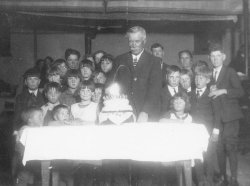
Charles Kimber Jr Birthday Party
In 1913 Charles had smallpox. Charles took in horses on trade on the store bill. At this particular time Clark Gavin traded him a horse that had only been worked a time or two. Charles wanted Winfred to work it a little so he could sell it. Being a bit leery, Winfred took his sleigh right into the corral to hook it up so the horse wouldn’t get away from him. The horse got its halter or bridle caught and threw itself down. Some of the kids saw it through the window and Charles got up and started out to help. Right before that Winfred had given him a good strong hot toddy to make him break out with the pox. The wood pile was down by the back gate of the house. Charles started staggering out to help and staggered until he reached the wood pile, where he fell in. Winfred laughed, he had a horse down in the corral and a dad down in the woodpile. The horse had gotten up on its own and Winfred went to help his dad back to the house. Winfred hooked up the horse and went on his way, laughing, because his dad had too much toddy. Actually the smallpox had affected Charles back and legs yet he only had a half dozen spots. This only affected him during his illness.
When Winfred was six or eight years old, he remembers his father had stomach trouble a lot and ate nothing but chicken and beef soup. After a big meal he could lose it if he went right out to work. He said what kept him healthy was fresh air. Apples were as regular as meals were. Charles would say “Go get the apples” if they were sitting around. He made lots of honey candy. He also made lazy bread, which the children really enjoyed.
Charles spent a lot of time singing with his children from the hymn book in the evenings and also would go to Blanthorn’s, his neighbors, and sing songs with them.
It wasn’t unusual at all when the family lived in the little log house to have three, four, five or six people stay with them besides the big family. Sometimes they had to sleep on the floor or three in a bed. Charles being in the horse business, people riding for horses came there and people working in the church came there and stayed a lot. Charles had many acquaintances. He was in business all his life. He had a horse business, and then cattle and also a store. In the business world Charles was well known and the family inherited part of it. Winfred would go places and if he said he was Charlie Kimber’s boy he could cash checks or anything. Whatever he did reflected back to the character that his Dad was.
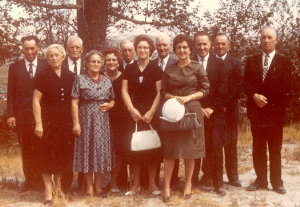
Raymond, Louisa Roberts, Elmer, Chloe Tanner, Elsie Smith, Rollo James (Jim), Vera Tanner, Osborne (OZ), Fern Shaw, Charles Junior, Edwin (Ted) and Winfred
Charles Kimber was a counselor in the MIA for sometime. He was made President on August 13, 1903 to April 30, 1916. He served with W.C. Betteridge and G.A. Blanthorn. Charles acted as a counselor in the Grouse Creek Ward Bishopric while A.F. Richins was on a mission 1903-1905. Charles served as first assistant in Sunday School from June 23, 1890 to October 26, 1891. He was in the Presidency of the MIA for twenty years. He liked kids and got along with everyone and hated to quit. Charles served on the old folks committee for several years with Allen N. Tanner and Amanda Tanner.
Charles was a very religious man and enjoyed discussing the principals of the Gospel, especially in his later years of life. He was a Book of Mormon scholar and had it nearly memorized. He read the Bible fluently.
Charles had a great desire to get his family records in shape and collected much of the data and dates which have helped in the Kimber genealogy. He was very interested in getting his families temple work done but somehow neglected to have himself sealed to his parents, thinking it was done. The sealing was done on June 7, 1949.
At the age of seventy-four Charles rode horseback over the mountain in deep snow as a missionary to Almo and Yost.
In the mornings, no matter if there was twelve or twenty of us, the family knelt to have prayer. Charles led in prayer all the time. After Charles died, Josephine led.
Although Charles had only five years of formal education he was a school trustee at Grouse Creek. He served as one of the first Box Elder County School Board members from 1906 to 1907, making trips by horse and buggy to the different schools as far as Snowville, which was in his district. He usually rode the train to the monthly meetings of the board at Brigham City, Utah. He supervised the building of schoolhouses in the western part of the county at the time, namely Muddy, Lucin, Lynn, Yost, Clear Creek and Stanrod.
He built and moved to a new two-story home in 1907-08. This home had carpets and wallpaper.
In 1909-1910 he, with E.S. Frost and Joseph Lee, built what was known as the upper dance hall and roller skating rink. Charles was a very progressive man. E.S. Frost, Tom Thomas, George Cook and John Burk obtained a franchise and built the telephone line for Grouse Creek and Etna, which served the people for many years and it went to Lucin, providing an opportunity to send telegrams, etc. Charles was an agent for Burton Implement Co., George A. Lowe Hardware Dealer, also C.W. Cross, who made and sold harnesses and saddles.
With few exceptions, Charles bought and sold all the buggies owned at Grouse Creek and a lot of the wagons, plows, mowing machines and also a thrashing machine, which he owned with E.S. Frost, his brother, William J. Kimber and Perry (Pell) Fenstermaker. From this he built a general merchandise business in Grouse Creek in 1910 for himself in the west room of his home. Charles later put up a building for the store just south of his home. The family operated this until 1913 when Charles sold the building and the dance hall. The store was moved into the dance hall and a hotel was made of the upstairs and back.
A few years later, the water system that served the south end of the valley was quite good but it didn’t serve the north end so Charles donated a spring of water he owned and the upper pipeline was built. They piped four miles of water down out of Charles field. The work was slow and hard. The men used picks and shovels to dig. Those having shares in the line were W.J. Kimber, Elizabeth Cook, Charles Lucas Sr. and Jr., Lorenzo Richins, B.A. and George Blanthorn, E.S. Frost, Will Hadfield, Charles Toyn, Eddie and Dave Frost.
In 1915 Charles got his first car. There were a lot of other cars around by then.
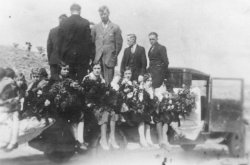
Charles Kimber Jr Funeral-1933
Charles Kimber was among the pioneers of this country, in every way possible helping his fellow men. He was a very generous person and gave without anyone knowing. He lived a good, honorable life. He died on May 11, 1933, at Grouse Creek, Utah at the age of eighty-two years and four months and was buried in the Grouse Creek Cemetery.
